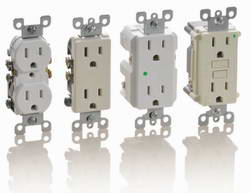» How to Wire a Wall Receptacle Outlet
» Need Electrical Help? Ask the Electrician
How to Wire 120Volt and 240Volt Outlets

|
Summary: Fully Explained Photos and Wiring Diagrams for Wiring Electrical Outlets with Code Requirements for most new or remodel projects covering 120 volt outlets for specific and general purpose circuits and 240 volt outlets of dedicated circuits used for large appliances and equipment.
© By: Dave Rongey |
Wiring 120volt Outlets and 240volt Outlets for Home Electrical Circuits
Wiring electrical outlets for Range and Dryer Power Outlets in flush mount, surface mount and panel mount versions come equipped with heavy-gauge, double-wire copper alloy contacts. To ensure correct wiring, terminals have ID markings.
Flush mount receptacles fit a wide range of wall plates and mounting hardware. The new code requirements of the 4-wire 220 volt and 240 volt outlets for clothes dryers provide for the required separate neutral wire.
Their is a lot of confusion about what to do about the electrical wiring connection with a 3-wire plug and a 4-wire plug. This is discussed and shown in the wiring diagrams on the pages linked at the right.
Electrical Wiring for 120Volt Outlets

GFI and GFCI Receptacle Outlets
Dishwasher Outlet
Disposal Outlet
Bedroom AFCI electrical-outlets
Switched Outlets
Half Hot Outlets
Electrical Wiring for 240Volt Outlets
Wiring electrical outlets for Range and Dryer Power Outlets in flush mount, surface mount and panel mount versions come equipped with heavy-gauge, double-wire copper alloy contacts.
To ensure correct wiring, terminals have ID markings. Flush mount receptacles fit a wide range of wall plates and mounting hardware.
The new code requirements of the 4-wire 220 volt and 240 volt outlets for clothes dryers provide for the required separate neutral wire.
Their is a lot of confusion about what to do about the electrical wiring connection with a 3-wire plug and a 4-wire plug. This is discussed and shown in the wiring diagrams on the pages linked at the right.
240 Volt Outlets

RANGE AND DRYER POWER OUTLETS
Kitchen Range and Oven Electrical Outlets
Clothes Dryers Electrical Outlets
NOTE: Both 220 and 240 volt outlets for the home are one in the same.
Newer homes have some 4-wire circuits which are referred to 120/240 Volt, which are typical for the electric dryer and the electric range.
In older homes you will find that the dryer or range may have the older 3-wire circuits which are commonly referred to as 220 volt circuits.
More about Wiring Outlets |
|
The Safest Way to Test Electrical Devices and Identify Electric Wires!The Non-Contact Electrical TesterThis is a testing tool that I have had in my personal electrical tool pouch for years, and is the first test tool I grab to help identify electrical wiring. It is a Non-contact tester that I use to easily Detect Voltage in Cables, Cords, Circuit Breakers, Lighting Fixtures, Switches, Outlets and Wires. Simply insert the end of the tester into an outlet, lamp socket, or hold the end of the tester against the wire you wish to test. Very handy and easy to use.
The Quickest Way to Check for Faulty Electrical Wiring!The Plug-In Outlet TesterThis is the first tool I grab to troubleshoot a problem with outlet circuit wiring. This popular tester is also used by most inspectors to test for power and check the polarity of circuit wiring. It detects probable improper wiring conditions in standard 110-125 VAC outlets Provides 6 probable wiring conditions that are quick and easy to read for ultimate efficiency Lights indicate if wiring is correct and indicator light chart is included Tests standard 3-wire outlets UL Listed Light indicates if wiring is incorrect Very handy and easy to use.
Strip Off Wire Insulation without Nicking and Damaging the Electric Wire!The Wire Stripper and Wire CutterMy absolute favorite wire stripping tool that I have had in my personal electrical tool pouch for years, and this is the tool I use to safely strip electrical wires. This handy tool has multiple uses: The wire gauges are shown on the side of the tool so you know which slot to use for stripping insulation. The end of the tool can be used to grip and bend wire which is handy for attaching wire onto the screw terminals of switches and outlets.. The wire stripper will work on both solid and stranded wire. This tool is Very Handy and Easy to Use. |
||
Outlets Parts and Accessories120volt Wall Outlet GFCI Outlet Switch and Outlet Combo |














